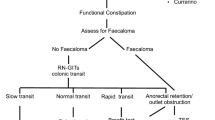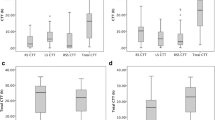Abstract
Background
Slow transit constipation (STC) is a form of chronic constipation characterised by prolonged passage of faecal matter through the colon. It is diagnosed by demonstrating delayed colonic transit on gastrointestinal transit studies. Traditionally, radio-opaque marker studies are performed. Recently, radioisotope nuclear transit studies (NTS) have been used in our centre to assess gastrointestinal transit time. This study aimed to evaluate if there are changes in colonic transit in STC children resistant to standard medical treatment over a prolonged period.
Methods
Children with STC resistant to standard medical therapy for ≥2 years who had undergone two separate NTS to assess their colonic transit (where the first study had identified slow colonic transit without anorectal retention) were identified after ethical approval. The geometric centre (GC) of radioisotope activity at 6, 24, 30 and 48 h was compared in the two transit studies to determine if changes occurred.
Results
Seven children (4 males) with proven STC resistant to standard medical therapy and two transit studies performed at different times were identified. Mean age was 7.0 years (5.4–10.8 years) at first study, and 11.4 years (9.7–14.2 years) at second study, with a mean of 4.4 years (1–8.5 years) between studies. There was no significant difference in colonic transit at any timepoint in the two tests (paired t test).
Conclusions
We conclude that nuclear transit studies are reproducible in assessing slow colonic transit in children with treatment-resistant STC and demonstrate that conventional medical treatment over many years has no effect on underlying colonic motility.


Similar content being viewed by others
References
Benninga MA, Buller HA, Tytgat GN, Akkermans LM, Bossuyt PM, Taminiau JA (1996) Colonic transit time in constipated children: does pediatric slow-transit constipation exist? J Pediatr Gastroenterol Nutr 23(3):241–251. doi:10.1097/00005176-199610000-00007
Hutson JM, McNamara J, Gibb S, Shin YM (2001) Slow transit constipation in children. J Paediatr Child Health 37(5):426–430. doi:10.1046/j.1440-1754.2001.00692.x
Drossman DA (1999) The functional gastrointestinal disorders and the Rome II process. Gut 45(Suppl 2):II1–II5
Wald A (2002) Slow transit constipation. Curr Treat Option Gastroenterol 5(4):279–283. doi:10.1007/s11938-002-0050-x
Ripetti V, Caputo D, Greco S, Alloni R, Coppola R (2006) Is total colectomy the right choice in intractable slow-transit constipation? Surgery 140(3):435–440. doi:10.1016/j.surg.2006.02.009
Zutshi M, Hull TL, Trzcinski R, Arvelakis A, Xu M (2007) Surgery for slow transit constipation: are we helping patients? Int J Colorectal Dis 22(3):265–269. doi:10.1007/s00384-006-0189-3
Sarli L, Iusco D, Donadei E, Costi R, Sgobba G, Violi V, Roncoroni L (2003) The rationale for cecorectal anastomosis for slow transit constipation. Acta Biomed 74(Suppl 2):74–79
Lundin E, Karlbom U, Pahlman L, Graf W (2002) Outcome of segmental colonic resection for slow-transit constipation. Br J Surg 89(10):1270–1274. doi:10.1046/j.1365-2168.2002.02213.x
Ghosh S, Papachrysostomou M, Batool M, Eastwood MA (1996) Long-term results of subtotal colectomy and evidence of noncolonic involvement in patients with idiopathic slow-transit constipation. Scand J Gastroenterol 31(11):1083–1091. doi:10.3109/00365529609036891
Marshall J, Hutson JM, Anticich N, Stanton MP (2001) Antegrade continence enemas in the treatment of slow-transit constipation. J Pediatr Surg 36(8):1227–1230. doi:10.1053/jpsu.2001.25768
King SK, Sutcliffe JR, Southwell BR, Chait PG, Hutson JM (2005) The antegrade continence enema successfully treats idiopathic slow-transit constipation. J Pediatr Surg 40(12):1935–1940. doi:10.1016/j.jpedsurg.2005.08.011
Sutcliffe JR, King SK, Southwell BR, Hutson JM (2004) Paediatric constipation for adult surgeons–article 1: targeting the cause. ANZ J Surg 74(9):777–780. doi:10.1111/j.1445-1433.2004.03149.x
Stanton MP, Shin YM, Hutson JM (2002) Laparoscopic placement of the Chait cecostomy device via appendicostomy. J Pediatr Surg 37(12):1766–1767. doi:10.1053/jpsu.2002.36717
Metcalf AM, Phillips SF, Zinsmeister AR, MacCarty RL, Beart RW, Wolff BG (1987) Simplified assessment of segmental colonic transit. Gastroenterology 92(1):40–47
Bouchoucha M, Devroede G, Arhan P, Strom B, Weber J, Cugnenc PH, Denis P, Barbier JP (1992) What is the meaning of colorectal transit time measurement? Dis Colon Rectum 35(8):773–782. doi:10.1007/BF02050328
Arhan P, Devroede G, Jehannin B, Lanza M, Faverdin C, Dornic C, Persoz B, Tetreault L, Perey B, Pellerin D (1981) Segmental colonic transit time. Dis Colon Rectum 24(8):625–629. doi:10.1007/BF02605761
Papadopoulou A, Clayden GS, Booth IW (1994) The clinical value of solid marker transit studies in childhood constipation and soiling. Eur J Pediatr 153(8):560–564. doi:10.1007/BF02190658
Maurer AH, Parkman HP (2006) Update on gastrointestinal scintigraphy. Semin Nucl Med 36(2):110–118. doi:10.1053/j.semnuclmed.2005.12.003
Rao S, Lele V (2002) Scintigraphy of the small intestine: a simplified standard for study of transit with reference to normal values. Eur J Nucl Med Mol Imaging 29(7):971–972. doi:10.1007/s00259-002-0842-1
Bonapace ES, Maurer AH, Davidoff S, Krevsky B, Fisher RS, Parkman HP (2000) Whole gut transit scintigraphy in the clinical evaluation of patients with upper and lower gastrointestinal symptoms. Am J Gastroenterol 95(10):2838–2847. doi:10.1111/j.1572-0241.2000.03195.x
Eising EG, von der Ohe MR (1998) Differentiation of prolonged colonic transit using scintigraphy with indium-111-labeled polystyrene pellets. J Nucl Med 39(6):1062–1066
McLean RG, King DW, Talley NA, Tait AD, Freiman J (1999) The utilization of colon transit scintigraphy in the diagnostic algorithm for patients with chronic constipation. Dig Dis Sci 44(1):41–47. doi:10.1023/A:1026689714120
McLean R, Smart R, Barbagallo S, King D, Stein P, Talley N (1995) Colon transit scintigraphy using oral indium-111-labeled DTPA. Can scan pattern predict final diagnosis? Dig Dis Sci 40(12):2660–2668. doi:10.1007/BF02220457
Maurer AH, Krevsky B (1995) Whole-gut transit scintigraphy in the evaluation of small-bowel and colon transit disorders. Semin Nucl Med 25(4):326–338. doi:10.1016/S0001-2998(95)80006-9
Cook BJ, Lim E, Cook D, Hughes J, Chow CW, Stanton MP, Bidarkar SS, Southwell BR, Hutson JM (2005) Radionuclear transit to assess sites of delay in large bowel transit in children with chronic idiopathic constipation. J Pediatr Surg 40(3):478–483. doi:10.1016/j.jpedsurg.2004.11.029
Zuccarello B, Romeo C, Scalfari G, Impellizzeri P, Montalto AS, D’Oppido D, Campenni A, Formica I, Baldari S (2006) Scintigraphic evaluation of colonic motility in patients with anorectal malformations and constipation. J Pediatr Surg 41(2):310–313. doi:10.1016/j.jpedsurg.2005.11.005
Notghi A, Hutchinson R, Kumar D, Tulley N, Harding LK (1994) Use of geometric center and parametric images in scintigraphic colonic transit studies. Gastroenterology 107(5):1270–1277
Notghi A, Hutchinson R, Kumar D, Smith NB, Harding LK (1994) Simplified method for the measurement of segmental colonic transit time. Gut 35(7):976–981. doi:10.1136/gut.35.7.976
Cremonini F, Mullan BP, Camilleri M, Burton DD, Rank MR (2002) Performance characteristics of scintigraphic transit measurements for studies of experimental therapies. Aliment Pharmacol Ther 16(10):1781–1790. doi:10.1046/j.1365-2036.2002.01344.x
Masoomi MA, Britten AJ, Kumar D, Joseph AE (1999) Inter-observer reproducibility of quantitative radionuclide colonic transit imaging. Nucl Med Commun 20(6):547–550. doi:10.1097/00006231-199906000-00009
Kamm MA, Lennard-Jones JE, Thompson DG, Sobnack R, Garvie NW, Granowska M (1988) Dynamic scanning defines a colonic defect in severe idiopathic constipation. Gut 29(8):1085–1092. doi:10.1136/gut.29.8.1085
McLean RG, Smart RC, Lubowski DZ, King DW, Barbagallo S, Talley NA (1992) Oral colon transit scintigraphy using indium-111 DTPA: variability in healthy subjects. Int J Colorectal Dis 7(4):173–176. doi:10.1007/BF00341215
Stubbs JB, Valenzuela GA, Stubbs CC, Croft BY, Teates CD, Plankey MW, McCallum RW (1991) A noninvasive scintigraphic assessment of the colonic transit of nondigestible solids in man. J Nucl Med 32(7):1375–1381
Degen LP, Phillips SF (1996) Variability of gastrointestinal transit in healthy women and men. Gut 39(2):299–305. doi:10.1136/gut.39.2.299
Chase J, Robertson VJ, Southwell B, Hutson J, Gibb S (2005) Pilot study using transcutaneous electrical stimulation (interferential current) to treat chronic treatment-resistant constipation and soiling in children. J Gastroenterol Hepatol 20(7):1054–1061
Clarke MCC, Chase JW, Gibb S, Robertson VJ, Catto-Smith AG, Hutson JM, and Southwell BR (2009) Decreased colonic transit time after transcutaneous interferential electrical stimulation in children with slow transit constipation. J Pediatr Surg 44:408–412
Clarke MC, Chow CS, Chase JW, Gibb S, Hutson JM, Southwell BR (2008) Quality of life in children with slow transit constipation. J Pediatr Surg 43(2):320–324. doi:10.1016/j.jpedsurg.2007.10.020
King SK, Sutcliffe JR, Hutson JM, Southwell BR (2004) Paediatric constipation for adult surgeons—article 2: new microscopic abnormalities and therapies. ANZ J Surg 74(10):890–894. doi:10.1111/j.1445-1433.2004.03202.x
Clarke MCC, Chase JW, Gibb S, Hutson JM, Southwell BR (2009) Improvement in quality of life in children with slow transit constipation following treatment with transcutaneous electrical stimulation. J Pediatr Surg (in press)
Sutcliffe JR, King SK, Hutson JM, Cook DJ, Southwell BR (2009) Gastrointestinal transit in children with chronic idiopathic constipation. Pediatr Surg Int. doi:10.1007/s00383-009-2374-2
Chaussade S, Roche H, Khyari A, Couturier D, Guerre J (1986) Measurement of colonic transit time: description and validation of a new method. Gastroenterol Clin Biol 10(5):385–389
Abrahamsson H, Antov S, Bosaeus I (1988) Gastrointestinal and colonic segmental transit time evaluated by a single abdominal X-ray in healthy subjects and constipated patients. Scand J Gastroenterol Suppl 152:72–80. doi:10.3109/00365528809095938
Hinton JM, Lennard-Jones JE, Young AC (1969) A new method for studying gut transit times using radioopaque markers. Gut 10(10):842–847. doi:10.1136/gut.10.10.842
Hutson JM, Chase JW, Clarke MCC, King SK, Sutcliffe J, Gibb S, Catto-Smith AG, Robertson VJ, Southwell BR (2009) Slow-transit constipation in children: our experience. Pediatr Surg Int. doi:10.1007/s00383-009-2363-5
van der Sijp JR, Kamm MA, Nightingale JM, Britton KE, Mather SJ, Morris GP, Akkermans LM, Lennard-Jones JE (1993) Radioisotope determination of regional colonic transit in severe constipation: comparison with radio opaque markers. Gut 34(3):402–408. doi:10.1136/gut.34.3.402
Proano M, Camilleri M, Phillips SF, Brown ML, Thomforde GM (1990) Transit of solids through the human colon: regional quantification in the unprepared bowel. Am J Physiol 258(6 Pt 1):G856–G862
Lundin E, Graf W, Garske U, Nilsson S, Maripuu E, Karlbom U (2007) Segmental colonic transit studies: comparison of a radiological and a scintigraphic method. Colorectal Dis 9(4):344–351. doi:10.1111/j.1463-1318.2006.01153.x
Stivland T, Camilleri M, Vassallo M, Proano M, Rath D, Brown M, Thomforde G, Pemberton J, Phillips S (1991) Scintigraphic measurement of regional gut transit in idiopathic constipation. Gastroenterology 101(1):107–115
Nam YS, Pikarsky AJ, Wexner SD, Singh JJ, Weiss EG, Nogueras JJ, Choi JS, Hwang YH (2001) Reproducibility of colonic transit study in patients with chronic constipation. Dis Colon Rectum 44(1):86–92. doi:10.1007/BF02234827
von der Ohe MR, Camilleri M (1992) Measurement of small bowel and colonic transit: indications and methods. Mayo Clin Proc 67(12):1169–1179
Author information
Authors and Affiliations
Corresponding author
Rights and permissions
About this article
Cite this article
Clarke, M.C.C., Chase, J.W., Gibb, S. et al. Standard medical therapies do not alter colonic transit time in children with treatment-resistant slow-transit constipation. Pediatr Surg Int 25, 473–478 (2009). https://doi.org/10.1007/s00383-009-2372-4
Accepted:
Published:
Issue Date:
DOI: https://doi.org/10.1007/s00383-009-2372-4




